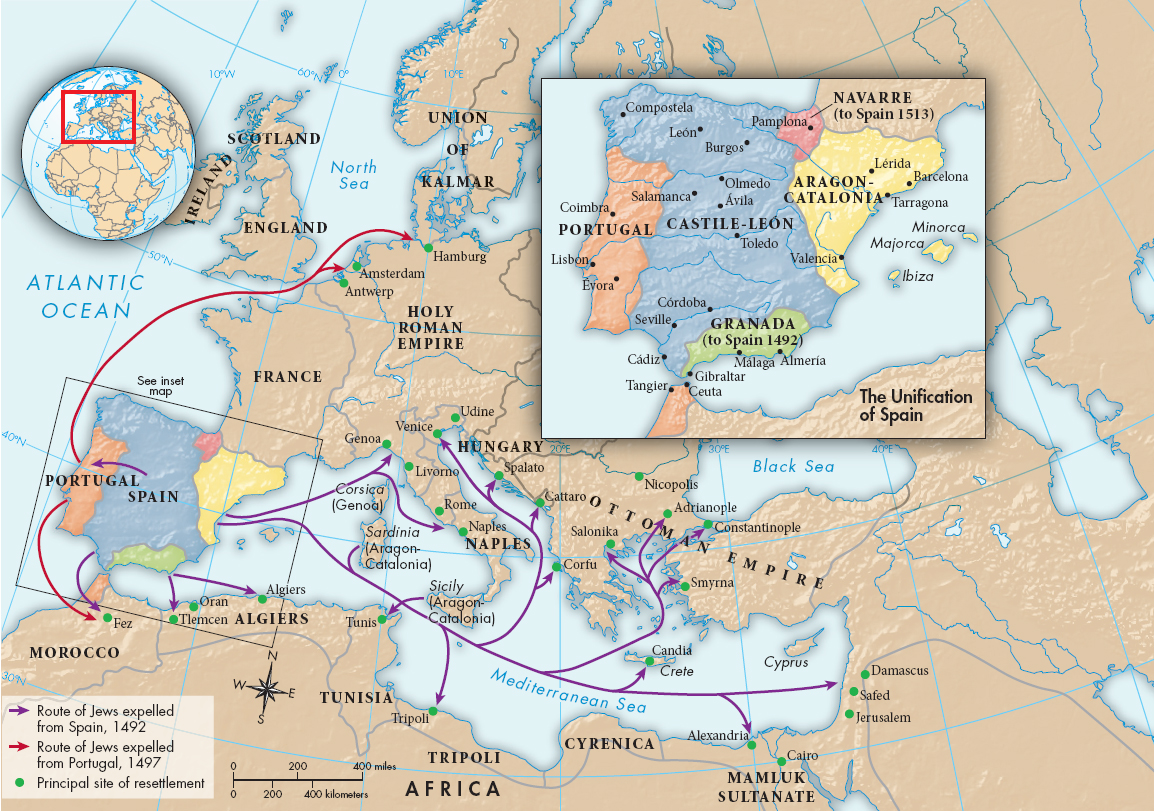Spain
While England and France laid the foundations of unified nation-

Ferdinand and Isabella were able to exert their authority in ways similar to the rulers of France and England, however. They curbed aristocratic power by excluding high nobles from the royal council. The council and various government boards recruited men trained in Roman law, which exalted the power of the Crown. They also secured from the Spanish Borgia pope Alexander VI the right to appoint bishops in Spain and in the Hispanic territories in the Americas, enabling them to establish the equivalent of a national church. With the revenues from ecclesiastical estates, they were able to expand their territories to include the remaining land held by Arabs in southern Spain. The victorious entry of Ferdinand and Isabella into Granada on January 6, 1492, signaled the conclusion of the reconquista (see Map 9.3). Granada was incorporated into the Spanish kingdom, and in 1512, Ferdinand conquered Navarre in the north.
There still remained a sizable and, in the view of the majority of the Spanish people, potentially dangerous minority, the Jews. When the kings of France and England had expelled the Jews from their kingdoms (see "Consequences of the Crusades" in Chapter 9), many had sought refuge in Spain. During the long centuries of the reconquista, Christian kings had recognized Jewish rights and privileges; in fact, Jewish industry, intelligence, and money had supported royal power. While Christians borrowed from Jewish moneylenders and while all who could afford them sought Jewish physicians, a strong undercurrent of resentment of Jewish influence and wealth festered.
In the fourteenth century anti-
Such successes bred resentment. Aristocratic grandees resented the conversos’ financial dependence, the poor hated the converso tax collectors, and churchmen doubted the sincerity of their conversions. (See “Tax Collectors,” page 367.) Queen Isabella shared these suspicions, and she and Ferdinand had received permission from Pope Sixtus IV in 1478 to establish their own Inquisition to “search out and punish converts from Judaism who had transgressed against Christianity by secretly adhering to Jewish beliefs and performing rites of the Jews.”2 Investigations and trials began immediately, as officials of the Inquisition looked for conversos who showed any sign of incomplete conversion, such as not eating pork.
Most conversos identified themselves as sincere Christians; many came from families that had received baptism generations before. In response to conversos’ statements, officials of the Inquisition developed a new type of anti-
In 1492, shortly after the conquest of Granada, Isabella and Ferdinand issued an edict expelling all practicing Jews from Spain. Of the community of perhaps 200,000 Jews, 150,000 fled. Many Muslims in Granada were forcibly baptized and became another type of New Christian investigated by the Inquisition. Absolute religious orthodoxy and purity of blood served as the theoretical foundation of the Spanish national state.
The Spanish national state rested on marital politics as well as military victories and religious courts. In 1496, Ferdinand and Isabella married their second daughter, Joanna, heiress to Castile, to the archduke Philip, heir to the Burgundian Netherlands and the Holy Roman Empire. Philip and Joanna’s son Charles V (r. 1519–
>QUICK REVIEW
How and why did the rulers of France, England, and Spain seek to undermine the independent power of the aristocracy?